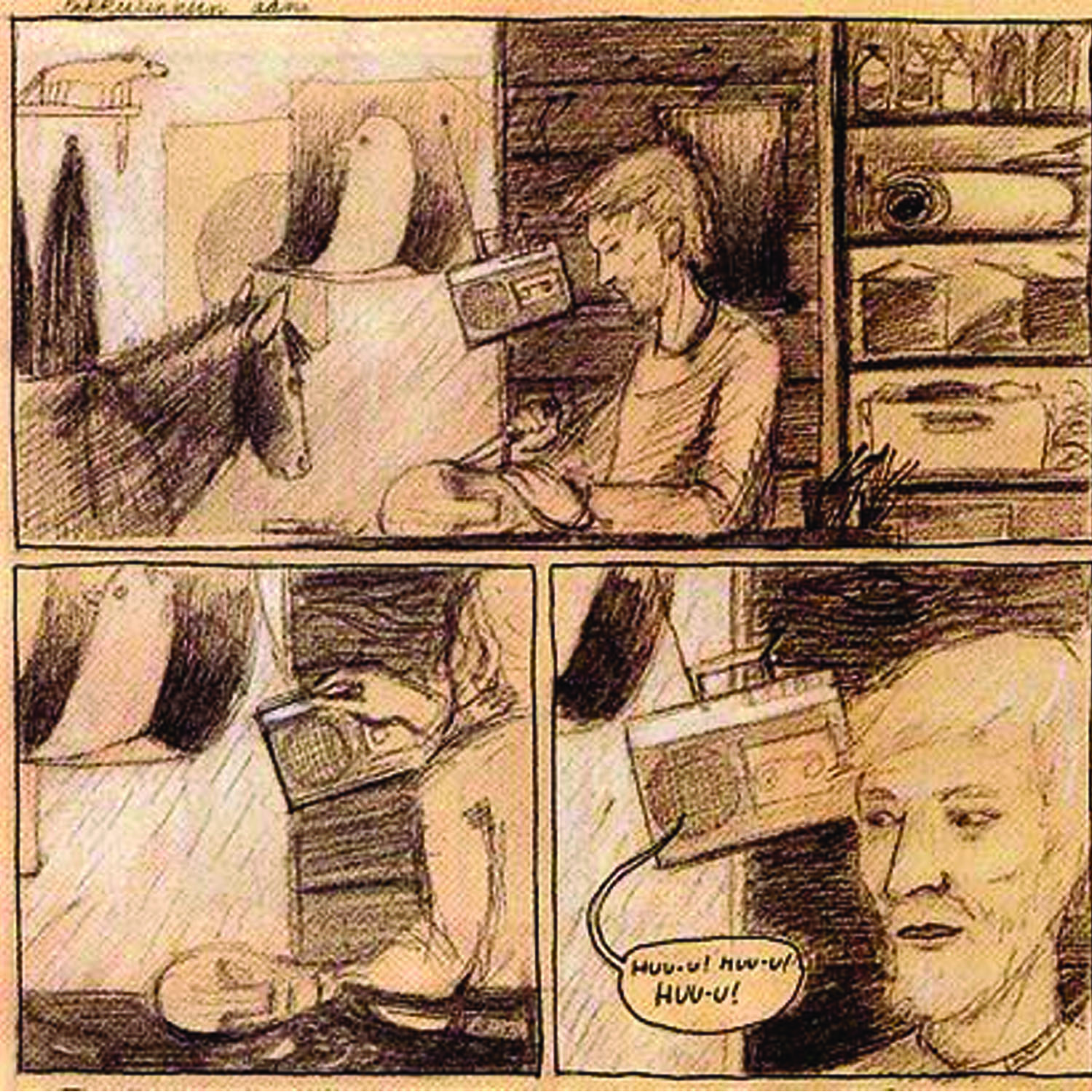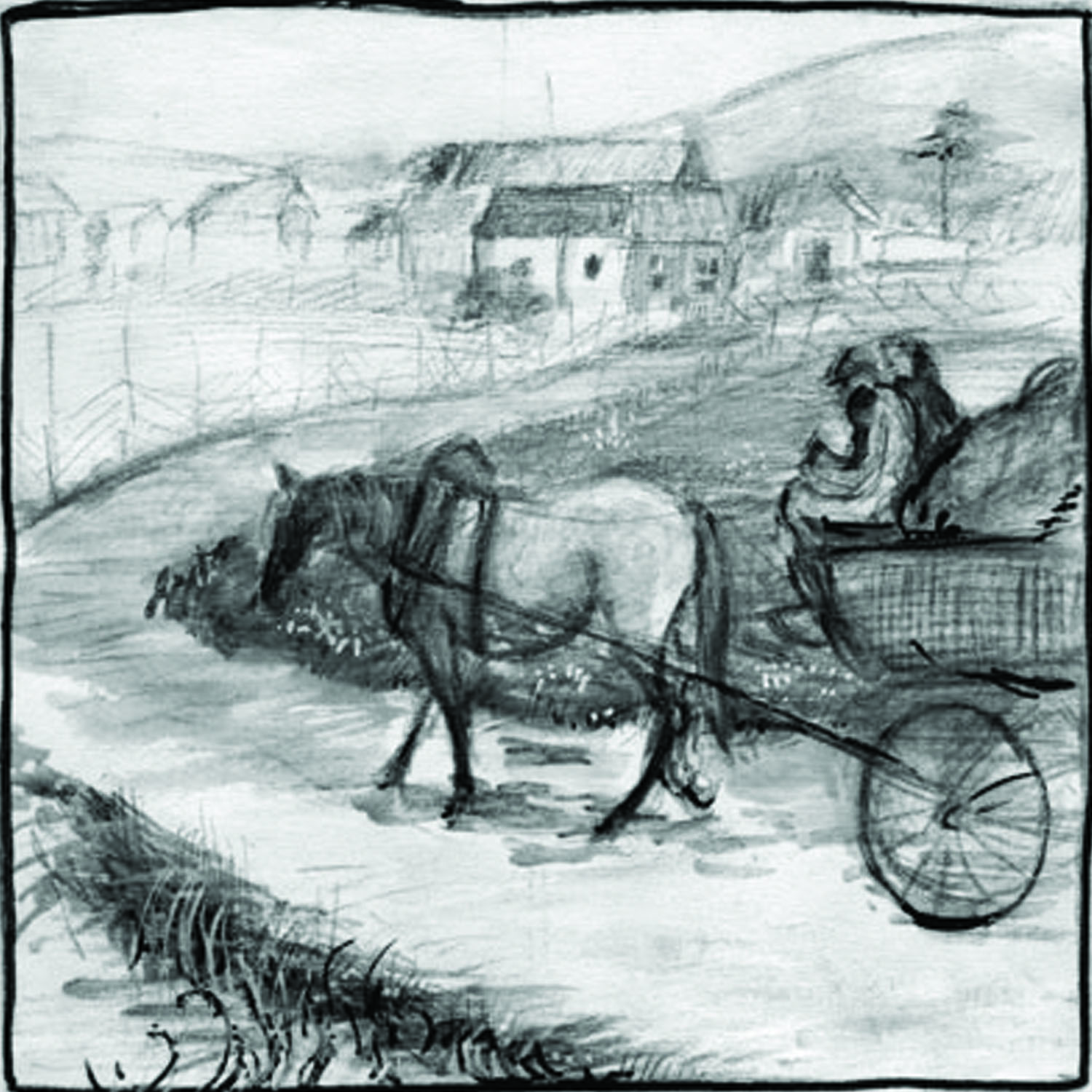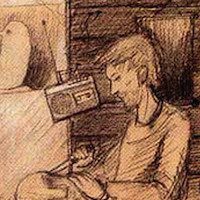The New York Comics & Picture-Story Symposium is a weekly forum for discussing the tradition and future of text/image work. Open to the public, it meets Tuesday nights 7-9 p.m. EST in New York City. Presentations vary weekly and include everything from historical topics and technical demonstrations to creators presenting their work. Check out upcoming meetings here.
The 108th meeting of the NY Comics & Picture-Story Symposium was held on Tuesday, November 18, 2014. Finnish cartoonist Hanneriina Moisseinen presented images from her most recent books, a trailer for the documentary Laulu about her life and work, and an animation showing a scene from Finnish history.
Fully one-fifth of the population of Finland inhabits the urban area around Helsinki, but a five-hour train ride north, in the provincial backwoods, among lots of snow and trees, straddling the Russo-Finnish border, is Karelia, an age-old community. Border changes may have occurred between  Finland and Russia over the centuries, but the indigenous population has always spoken the Karelian language, sung Karelian songs, and told Kerlian stories.
Finland and Russia over the centuries, but the indigenous population has always spoken the Karelian language, sung Karelian songs, and told Kerlian stories.
This is where cartoonist Hanneriina Moisseinen was born, in the town of Joensuu, Finland. She read American comics growing up, from Superman to Donald Duck, translated into Finnish, and, like children of every nationality, would draw during boring classes in high school. She eventually met Tommi Musturi, who published a minicomic called Glomp which had premiered in 1997, and soon became a regular contributor. Moisseinen also went to art school, where she did everything other than comics, including a sculptural installation that included a life-size figurative piece made of stones.
She soon found the topic that would define her life’s work: the region and customs of Karelia itself. Karelia is called “The Land of Songs” for its storytelling traditions, which Moisseinen celebrates and describes in her graphic novels, determined to preserve Karelian culture before it disappears. She has journeyed at least once to the other side of the Russian border, collected what are called “shameless stories” or “embarrassments,” from old Karelians, and then written and drawn them. Moisseinen’s debut collection of comics, Syn Synty (2005) is a set of illustrated “shameless stories,” funny and sad at the same time.
In addition to shameless stories, Moisseinen’s work tells shameful stories, the difference being that one has a moral, whereas the other is just enjoyed for its entertainment value. One otherwise shy man recounted an entire hour’s worth of stories for her, including one anecdote of a kid and his sister’s sexual education and their puzzled parents (which got a big laugh out of symposium attendees). Karelian literature often makes fun of priests and salesmen (who are typically portrayed as having the loosest morals) in small village societies where the priests and salesmen hold the greatest power. What eddas and sagas are to Iceland and Scandinavia, embarrassments are to this channel of Finnish oral literature. By the time the first Finnish national epic was publihed in 1865, and long before the modern nation of FInland achieved independence in 1917, shameless stories had been sung for generations. The follow-up to Syn Synty, Setit ja partituurit (“Sets and Scores”) contains more contemporary stories about embarrassing situations in daily life.
Moisseinen’s work gathering stories and other elements of Karelian culture grew into a twenty year project. One of her most vital sources of Karelian lore was a woman named Santra Ramsujeva (who later died at age 95). She was “like a radio,” knitting and continuously talking. Jussi Huovinen, the only participant one who still lives in Finland, was another resource. A bound edition of Glomp (#10) appeared in 2009, containing stories both shameless and shameful, drawn in different styles (“I don’t have a style–I was just trying to draw comics” claims Moisseinen). These stories, please note, claim to be true and not merely folklore.
Laulu, the documentary telling Moisseinen’s own story, premiered in Finland this year and was recently screened at an Ohio academic conference. In Laulu, that indefatigable singer of Karelian runes, Jussi Huovinen, shows up again, pipe in hand, to tell shameless stories. Moisseinen traveled to the Russian part of Karelia to pay a visit to Huovinen’s house, and then lived there. There was no electricity or running water (one of Moisseinen’s jobs was to help gather firewood). Huovinen taught her songs from the Karelian tradition, accompanying his voice on accordion and violin. How does rune-singing connect with comics? “Just a different means of storytelling,” Moisseinen explains.
Isä (2013) tells the story of how Moisseinen’s father disappeared with no reason when she was ten years old. He never came back. Moisseinen wants to invite her father back with this book. Isä (Finnish for “father”) is made up of the surviving memories of a girl who  doesn’t want to lose whatever memories still remain. Moisseinen contacted all her father’s old coworkers, cops, and others, in a tireless detective endeavor. These stories are drawn in mixed media in black and white pencil revealing characters from their own inner worlds. The attempt here is to record as many memories as she can before they, too, fade and disappear. “When you have lost memories, you have lost everything,” Moisseinen says. More than that, she wants to establish that before her father disappeared they were a normal family.
doesn’t want to lose whatever memories still remain. Moisseinen contacted all her father’s old coworkers, cops, and others, in a tireless detective endeavor. These stories are drawn in mixed media in black and white pencil revealing characters from their own inner worlds. The attempt here is to record as many memories as she can before they, too, fade and disappear. “When you have lost memories, you have lost everything,” Moisseinen says. More than that, she wants to establish that before her father disappeared they were a normal family.
Her current project, Syntymäpäivä , or “Birthday,” encompasses photography, installation, and other media about Karelian history, primarily on the themes of war and evacuation. Music and dance are published as part of the experience. Moisseinen screened a short animation at the Symposium about an evacuation, told in rubbed-out charcoal pencil on textured paper. “Two minutes to leave the village!” cries one character. In another scene, a family shoots its own perfectly healthy calf because they know the animal would never survive the journey to their destination.
Moisseinen’s non-comic art and her comics have begun to integrate. In recent years, Moisseinen has been challenging the limits of comic expression by including sewing and embroidery in her published work. She also embroiders comics and samplers on “holy clothes” or “holy towels,” garments traditionally used in weddings, funerals, and other religious services. They’re also used as shrouds, or hung ffrom fences and trees to invite the soul of a dead person for one last time. “One by one, life sheds its petals.” reads one of Moisseinen’s samplers. Another, perhaps the most revealing of all Moisseinen’s work, simply states,”Love conquers all.”
***
Image credits:
Image 1: Comic story from the Finnish minicomic Glömp.
Image 2: “The Swearing Matron,” Artwork © 2014 Hanneriina Moisseinen. Website image © Lambiek.




